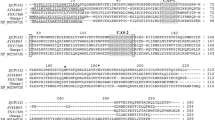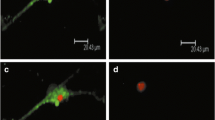Abstract
Cystatin play an important role in parasite immune evasion. It is involved in many immune responses processes regulations such as inhibiting antigen presentation, modifying cytokines production and macrophage polarization. In recent years, more and more cystatins were used in treating some inflammatory diseases such as asthma and inflammation bowel diseases; however, cystatins from Schistosoma japonicum were rarely studied. In the present study, we have cloned a cystatin from the adult stage of Schistosoma japonicum, named as SjCystatin, and its sequence shares conserved domains with other type II family cystatins. It was further verified by enzyme inhibition assays. SjCystatin retained its inhibitory activity under a wide range of pH values and temperatures, can maintain its inhibitory activity at pH 6.5–7.5 and 37 °C, respectively. Then, we investigated the effects of SjCystatin on the lipopolysaccharide (LPS)-induced activated RAW264.7. Results showed that SjCystatin inhibit LPS-induced nitric oxide production in a dose-dependent manner. LPS-induced TNF-α and IL-6 production began to be inhibited at least 6 h after SjCystatin stimulation. SjCystatin significantly increased IL-10 production at 6 h after stimulation and its effect on IL-10 production diminished quickly. These results imply that SjCystatin can induce M2 macrophage polarization and can be expected to serve as a potential drug source for the medication of inflammatory disorders like other cystatins.








Similar content being viewed by others
References
Abrahamson M, Alvarez-Fernandez M, Nathanson CM (2003) Cystatins. Biochem Soc Symp 70:179–199
He B, Cai G, Ni Y, Li Y, Zong H, He L (2011) Characterization and expression of a novel cystatin gene from Schistosoma japonicum. Mol Cell Probes 25(4):186–193. doi:10.1016/j.mcp.2011.05.001
Hewitson JP, Grainger JR, Maizels RM (2009) Helminth immunoregulation: the role of parasite secreted proteins in modulating host immunity. Mol Biochem Parasitol 167(1):1–11. doi:10.1016/j.molbiopara.2009.04.008
Jang SW, Cho MK, Park MK, Kang SA, Na BK, Ahn SC, Kim DH, Yu HS (2011) Parasitic helminth cystatin inhibits DSS-induced intestinal inflammation via IL-10(+)F4/80(+) macrophage recruitment. Korean J Parasitol 49(3):245–254. doi:10.3347/kjp.2011.49.3.245
Kima PE (2007) The amastigote forms of Leishmania are experts at exploiting host cell processes to establish infection and persist. Int J Parasitol 37(10):1087–1096. doi:10.1016/j.ijpara.2007.04.007
Klotz C, Ziegler T, Danilowicz-Luebert E, Hartmann S (2011a) Cystatins of parasitic organisms. Adv Exp Med Biol 712:208–221. doi:10.1007/978-1-4419-8414-2_13
Klotz C, Ziegler T, Figueiredo AS, Rausch S, Hepworth MR, Obsivac N, Sers C, Lang R, Hammerstein P, Lucius R, Hartmann S (2011b) A helminth immunomodulator exploits host signaling events to regulate cytokine production in macrophages. PLoS Pathog 7(1):e1001248. doi:10.1371/journal.ppat.1001248
Liu YH, Han YP, Li ZY, Wei J, He HJ, Xu CZ, Zheng HQ, Zhan XM, Wu ZD, Lv ZY (2010) Molecular cloning and characterization of cystatin, a cysteine protease inhibitor, from Angiostrongylus cantonensis. Parasitol Res 107(4):915–922. doi:10.1007/s00436-010-1952-5
Mantovani A, Sica A, Sozzani S, Allavena P, Vecchi A, Locati M (2004) The chemokine system in diverse forms of macrophage activation and polarization. Trends Immunol 25(12):677–686
Marco M, Baz A, Fernandez C, Gonzalez G, Hellman U, Salinas G, Nieto A (2006) A relevant enzyme in granulomatous reaction, active matrix metalloproteinase-9, found in bovine Echinococcus granulosus hydatid cyst wall and fluid. Parasitol Res 100(1):131–139
Murray J, Manoury B, Balic A, Watts C, Maizels RM (2005) Bm-CPI-2, a cystatin from Brugia malayi nematode parasites, differs from Caenorhabditis elegans cystatins in a specific site mediating inhibition of the antigen-processing enzyme AEP. Mol Biochem Parasitol 139:197–203
Sander AF, Lavstsen T, Rask TS, Lisby M, Salanti A, Fordyce SL, Jespersen JS, Carter R, Deitsch KW, Theander TG, Pedersen AG, Arnot DE (2013) DNA secondary structures are associated with recombination in major Plasmodium falciparum variable surface antigen gene families. Nucleic Acids Res. [Epub ahead of print]
Schnoeller C, Rausch S, Pillai S, Avagyan A, Wittig BM, Loddenkemper C, Hamann A, Hamelmann E, Lucius R, Hartmann S (2008) A helminth immunomodulator reduces allergic and inflammatory responses by induction of IL-10-producing macrophages. J Immunol 180:4265–4272
Schönemeyer A, Lucius R, Sonnenburg B, Brattig N, Sabat R, Schilling K, Bradley J, Hartmann S (2001) Modulation of human T cell responses and macrophage functions by onchocystatin, a secreted protein of the filarial nematode Onchocerca volvulus. J Immunol 167(6):3207–3215
Sun X, Liu YH, Lv ZY, Yang LL, Hu SM, Zheng HQ, Hu W, Cao JP, Fung MQ, Wu ZD (2010) rSj16, a recombinant protein of Schistosoma japonicum-derived molecule, reduces severity of the complete Freund’s adjuvant-induced adjuvant arthritis in rats’ model. Parasite Immunol 32(11–12):739–48. doi:10.1111/j.1365-3024.2010.01240.x
Tarasuk M, Vichasri Grams S, Viyanant V, Grams R (2009) Type I cystatin (stefin) is a major component of Fasciola gigantica excretion/secretion product. Mol Biochem Parasitol 167(1):60–71. doi:10.1016/j.molbiopara.2009.04.010
Wu C, Cai P, Chang Q, Hao L, Peng S, Sun X, Lu H, Yin J, Jiang N, Chen Q (2011) Mapping the binding between the tetraspanin molecule (Sjc23) of Schistosoma japonicum and human non-immune IgG. PLoS One 20(6):e19112. doi:10.1371/journal.pone.0019112
Yang F, Sun X, Shen J, Yu LP, Liang JY, Zheng HQ, Wu ZD (2013) A recombined protein (rSj16) derived from Schistosoma japonicum induces cell cycle arrest and apoptosis of murine myeloid leukemia cells. Parasitol Res 112(3):1261–1272. doi:10.1007/s00436-012-3260-8
Acknowledgments
This work was supported in part by a grant from the Pearl River Scholar Programme (80000-3210003), the National Natural Science Foundation of China (81370215) and the China Postdoctoral Science Foundation (2013 M540677).
Conflict of interest
The authors declare that they have no conflict of interest.
Author information
Authors and Affiliations
Corresponding author
Additional information
Xiao Yang and Ju Liu contribute equally to this work
Rights and permissions
About this article
Cite this article
Yang, X., Liu, J., Yue, Y. et al. Cloning, expression and characterisation of a type II cystatin from Schistosoma japonicum, which could regulate macrophage activation. Parasitol Res 113, 3985–3992 (2014). https://doi.org/10.1007/s00436-014-4064-9
Received:
Accepted:
Published:
Issue Date:
DOI: https://doi.org/10.1007/s00436-014-4064-9




